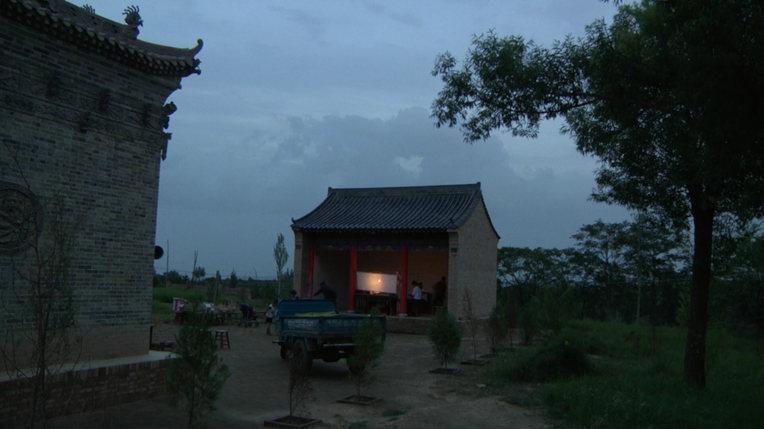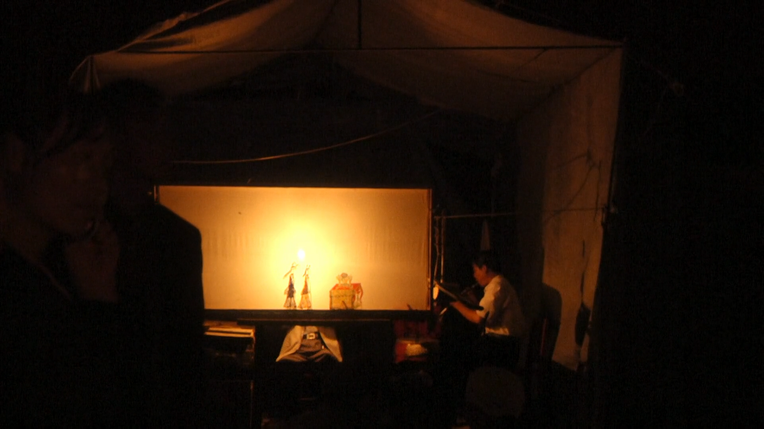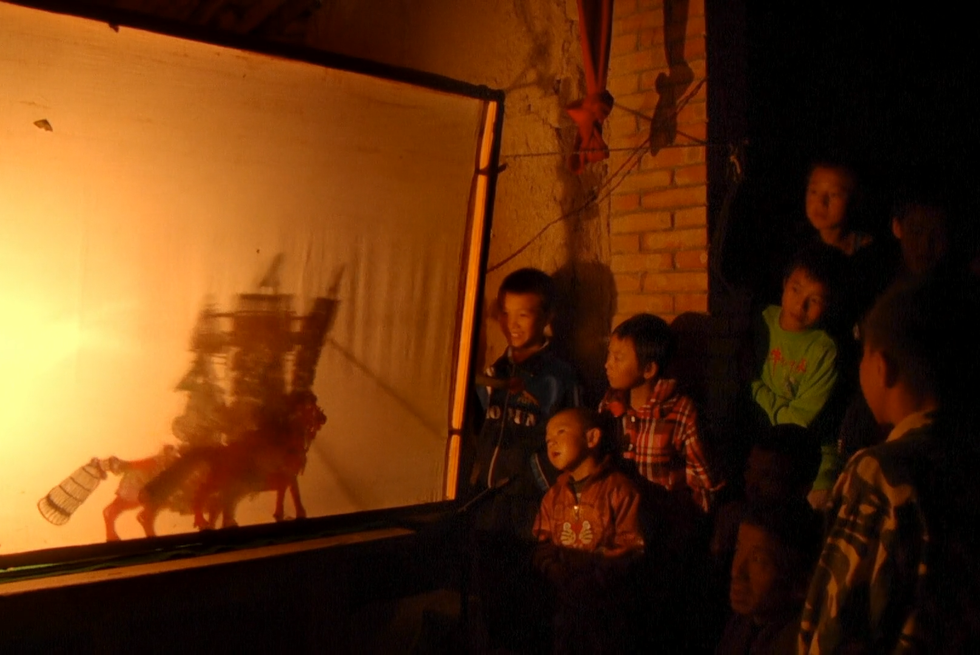Distributor Icarus Films writes that Yi Cui's Of Shadows (2016) juxtaposes “the rural and the urban, the grassroot and the official, the state and the local, the light and the shadow.” Though a film of contrasts, its meanings seep into the porous in-between: like the see-through fabric used in shadow theater, Of Shadows builds images around ultrathin layers of aesthetic styles and strategies. Mainly composed of fixed-camera durational shots, the film offers an intimate portrait of a predominantly male Huan Xian–based troupe of shadow players, who traverse the vast landscapes of the Loess Plateau to entertain people and deities alike.
Documentary cinema, as suggested in recent Oscar winners Icarus and Free Solo, still largely prefers interviews as a structuring device. In Of Shadows, conversations are sparse and isolated. Instead, the film revolves around everyday routines, nonverbal gestures and the measures of folk music. But when Yi Cui does insist on speech, it’s not to make a statement or provide context; instead, the film shows snippets of conversation that lead nowhere in particular and oftentimes display the bold act of filmmaking itself. Most emblematic of the filmmaker’s approach to cinema is when she starts interviewing one of the performers and is interrupted by construction work across the street. Because of the deafening noise of a bulldozer, they can’t hear one another, chuckle about the timing of it all, and decide to continue the conversation later. But that moment never comes, or at least not during the film’s seventy-nine minutes of screen time.
The interview punctures the illusions of cinema. Here, conversations are constantly cut off and shaped by the rhythms and intensities of the everyday. The film embraces cinematic excess, or the details that don’t directly contribute to traditional forms of filmic storytelling. Yet these details are meaningful nevertheless: unexpected gestures, textures of surfaces and sonic minutiae ensure that images can exist in and of themselves, without the risk of being colonized by expository or explanatory voice-overs. By primarily focusing on everyday skillful experiences and unexpected encounters, Of Shadows sets itself the aim of reverberating the atmosphere of shadow theater. Similar to how such plays are arranged around intimate intersections between performers, spectators, and environments, the film turns to the intricate compositions of social life—and allows itself to call attention to moments of confusion and contingency.

As a result, the film doesn’t provide much context about the geographies and economics of the theater troupe, nor about the traditions of these plays. Instead of such grand gestures, the film stresses the more practical variables that might affect shadow plays: weather patterns, the health of the performers, the acoustics of an outdoor stage. Of Shadows is as much an intimate portrait of a small group of nomads who strive for perfection as it presses close on a phenomenology of spectatorship. At some point, the film attends to a handful of children who move as close as they can to the yellow-red screen, where they can take a peek behind the curtains to uncover the audiovisual spectacle. A couple of boys are even more daring and sit right in between the performers and other spectators—seeing both the puppets and the shadows they cast. It’s on the borderline of the visible and the invisible that they find something that resonates with them.
In some respects, Of Shadows echoes the tonality of Zhao Liang’s Behemoth (2015) in its tentative concern with the magnetic affects of modernity. Both filmmakers emphasize how minute routines and ethereal forms of expression are always under duress—whether that’s because of power relations or the far-reaching registers of the everyday. Yet this is no salvage ethnography, nor a bitter assessment of a culture in flux. Rather, Of Shadows positions the pre-cinematic medium of shadow theater in a contemporary context, without much nostalgia or despair. As the script of one of the troupe’s performances reads, “The scientific outlook is at work; healthcare and pensions are insured. All expenses are waived. The country is stronger, the people richer. There are no worries about food and housing, travel is convenient . . . University graduates and postgraduates are joining the village leadership.” Even though the formal modality of shadow plays might be hundreds of years old, its thematic foci are by definition archaic or unable to reflect on current sociopolitical issues.

The film briefly elaborates on how the shadow theater of Huan Xian has made its way to the east coast of China, and even to western Europe. Such trips result in higher ticket sales than regional performances, frustrating some of the troupe’s purists. As one of the performers says in the film’s most extensive interview:
What should I say? I’ve never been abroad. The longest distance I’ve traveled is Shanghai, to perform there, and to Xi Feng City many times. That’s not a real performance; it’s about coping with some official business. You get an order to entertain some officials, or there is a big event, and we shadow play performers are called in to participate. They gather some people to put on a show. It has to be short, no more than five or ten minutes. You finish this serious job, they pay you a couple bucks, then you fuck off.
Of Shadows leaves many things unsaid and fragmented. It attracts and repulses moments of social commentary, borrowing as much from documentary cinema as it does from structural film. The bliss of Yi Cui’s film is its refusal to juxtapose the new and the old, the image and the text, the real and the illusory. The film gives room to that which is porous and, in so doing, draws nearer to the construction and felt experience of rites of passage.
References
Zhao, Liang, dir. 2015. Behemoth. 95 min.
